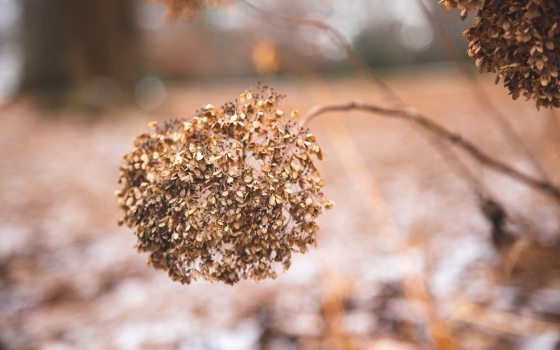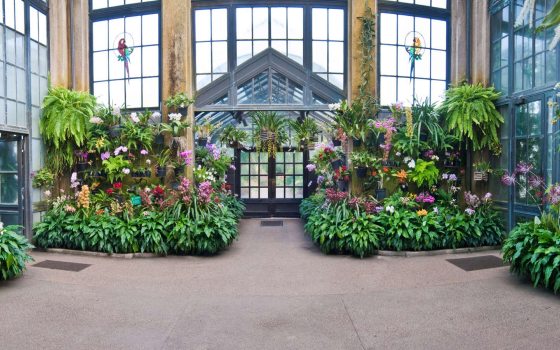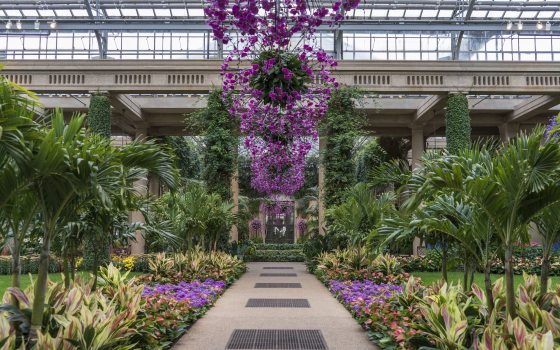As Longwood’s director of Outdoor Landscapes, I am always excited about winter. It’s one of my favorite seasons and when the interaction between a garden and its surrounding landscape is at its strongest. The bare silhouettes of the deciduous trees, shrubs, perennials, and grasses create a natural link to the wintery landscape beyond, creating a beauty unlike any other time of year. Low winter light really helps to elevate fine plant details, naturally highlighting the winter bones of Longwood.
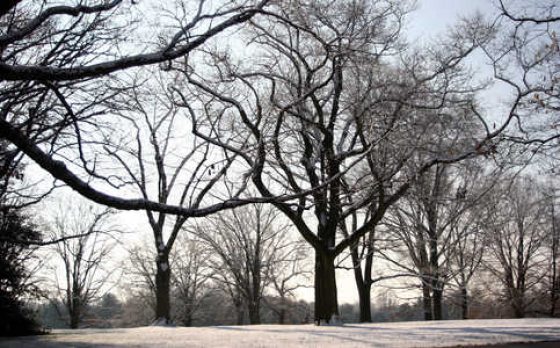
A collection of native oaks in their winter dress stands tall in Oak and Conifer Knoll. Photo by Aubree Pack.
At this time of year, I am so appreciative of the presence of trees in a garden because they build a relationship to the sky that seems so much larger and more dramatic. Here at Longwood, as you stroll through Oak and Conifer Knoll, you might notice individual specimens of Eastern white pine (Pinus strobus). These trees tend to be along the periphery of the Gardens, including in Oak and Conifer Knoll, where they frame the nearby Main Fountain Garden and Idea Garden.
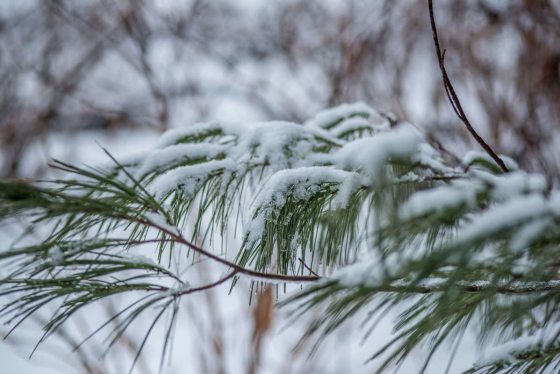
The Eastern white pine offers an iconic shape in the Longwood landscape. Photo by Hank Davis.
I have a soft spot for Eastern white pine because of its transparent appearance. It allows the sky to peek through its fine structured crown—an unusual attribute for an evergreen tree, which usually has a green solid presence in a garden. But I also like Eastern white pine because of its relationship with ice storms, as even when it is battered by a storm, it takes on a unique shape that is still graceful and beautiful.
One of my favorite pines at Longwood is on the south side of the Peirce-du Pont House, planted during our founder’s time. Its iconic habit, or general appearance and growth form, has been affected during many past winters as it lost major limbs in ice storms, but it continues to grow and remind me that the garden and its surrounding landscape is in constant flux.
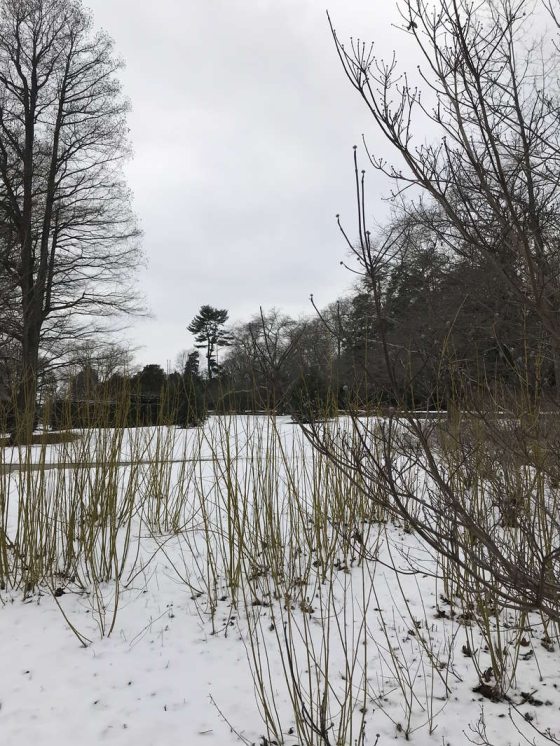
Seen in the background, this Eastern white pine’s changing form is a reminder of Longwood’s constant flux. Photo by Andrea Brunsendorf.
When you visit Longwood in the winter, you may also find yourself in the Hillside Garden, which features a well-established seasonal winter layer, thanks to its bark and buds on trees and shrubs, as well as a variety of seed heads. If you happen to visit one afternoon, look for low sun backlighting the coppery paper-like bark of our native river birches (Betula nigra), which is a special moment. No matter what time of day you stroll through the Hillside Garden, look for the tight silvery velvet flower buds of Edgeworthia chrysantha and picture the potential of them opening up into yellow pompoms to greet the early spring—if the late frost allows and the elements play out just right.
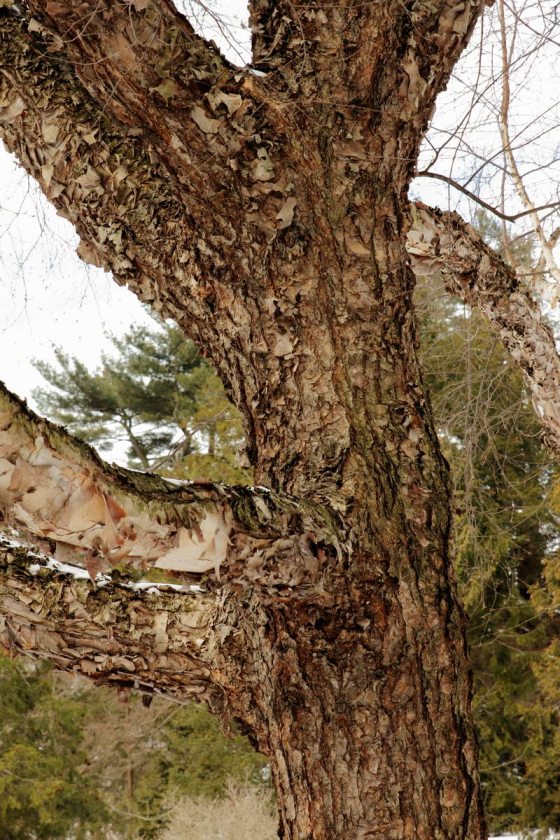
Native to the eastern United States, Betula nigra shines in the winter with its coppery bark. Photo by Richard Donham.
Along the north slope of the Hillside Garden, take a moment to admire the delicate structure of grasses such as Calamagrostis × acutiflora ‘Karl Foerster’ in combination with small button-like seed heads of other native perennials, such as the mountain-mint (Pycnanthemum muticum). Also in the Hillside Garden, look along the path edges and find dancing golden seed heads of Begonia grandis, or observe how the ponticum rhododendron (Rhododendron ponticum) curls up its evergreen leaves in order to reduce leaf surface and protect itself from dehydration and intense winter sun—the colder the day, the tighter it curls!
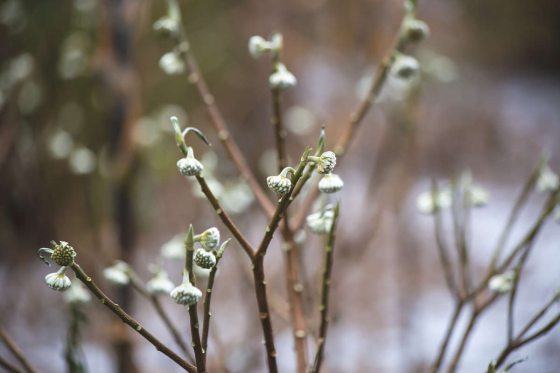
Edgeworthia chrysantha features silvery velvet flower buds in the winter. Photo by Carol DeGuiseppi.
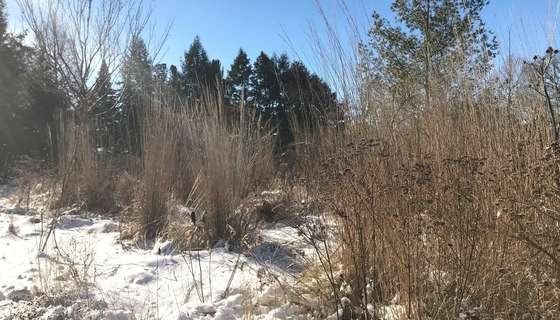
Calamagrostis × acutiflora ‘Karl Foerster’ and mountain-mint (Pycnanthemum muticum) add winter texture to the Hillside Garden. Photo by Andrea Brunsendorf.
Winter also unveils the often most overlooked components of a garden, making it a good time to reflect on a garden’s seasonal layers and planting potential throughout the year. Good summer planting schemes are easy to achieve when compared to creating a plant palette of winter interest that can then merge into spring and disappear into the lushness of summer plantings. It is a design challenge that the horticulturists at Longwood consider when designing their individual garden spaces. When planning for winter, we look at trees and shrubs to support the winter layer. Bald-cypress (Taxodium distichum) and its light brown fine skeleton is another tree that stands out at this time of year. You can find a beautiful grove of these trees in Peirce’s Woods, where you can enjoy a close look at the detail of their fine branches.

A grove of Taxodium distichum var. imbricarium 'Prairie Sentinel' awaits in Peirce’s Woods. Photo by Candie Ward.
However, a seasonal winter layer in Longwood is not solely composed of woody plants, as there are also herbaceous plants to consider, including their ability to enhance the winter scene. We particularly try to keep seed heads of perennials such as coneflowers, the fronts of ostrich fern, or the delicate structures and blooms of our ornamental grasses up throughout the coldest season. You can enjoy these beauties in the Hillside Garden, as well as along the perennial border in the Idea Garden. There is a certain romance in seeing the fragile seed heads of the moor grass (Molinia) wildly dancing in the cold winter wind and sun … hinting at seasons to come.

Native Hydrangea arborescens can be found in Peirce’s Woods, a wintertime masterpiece with a well-developed seasonal layer. Photo by Carol DeGuiseppi.
